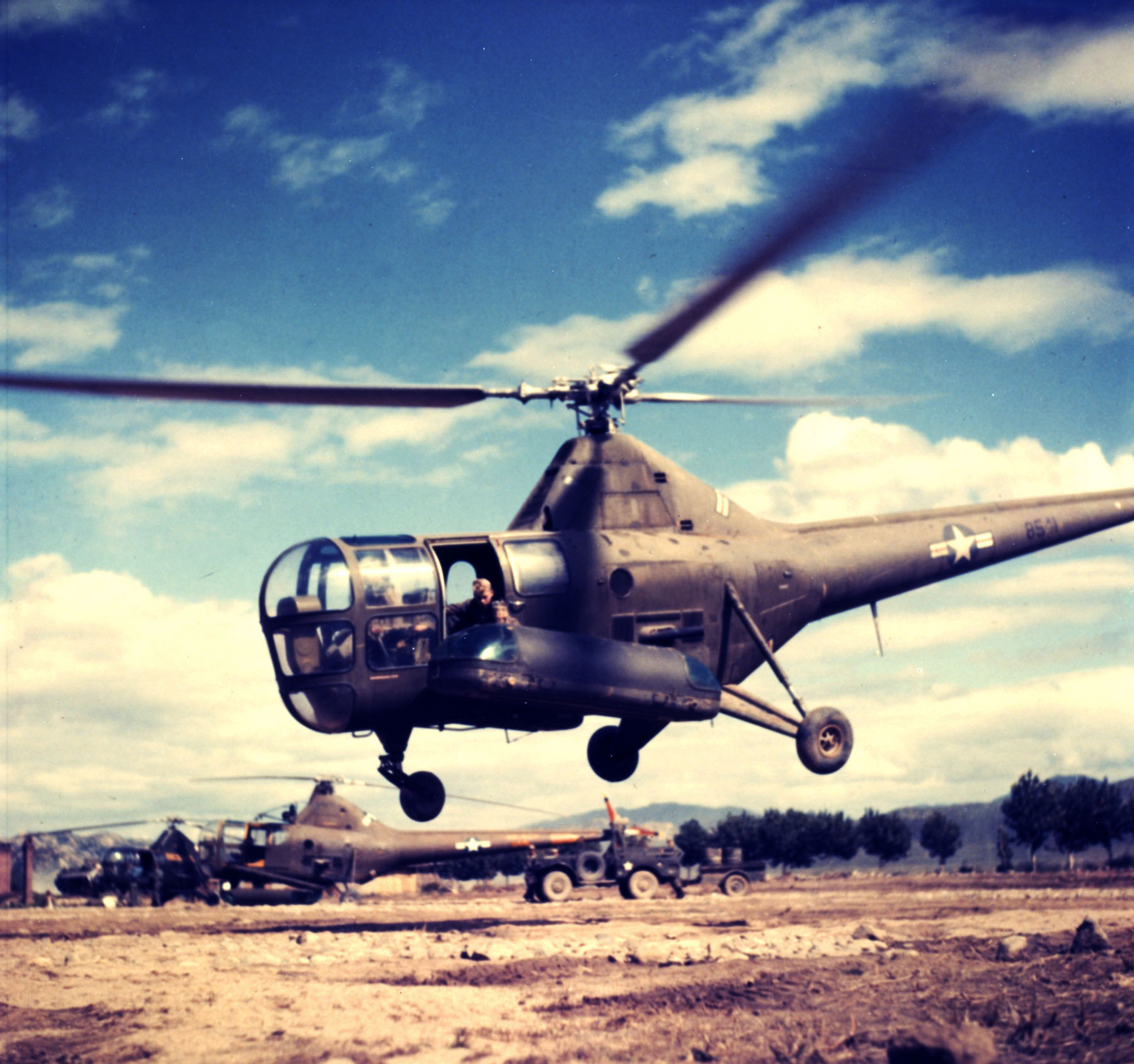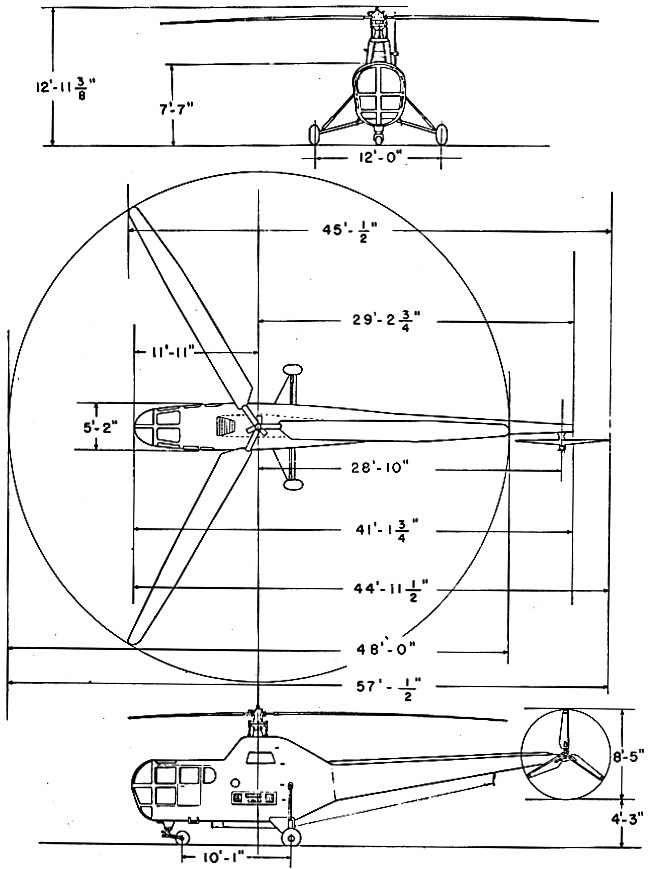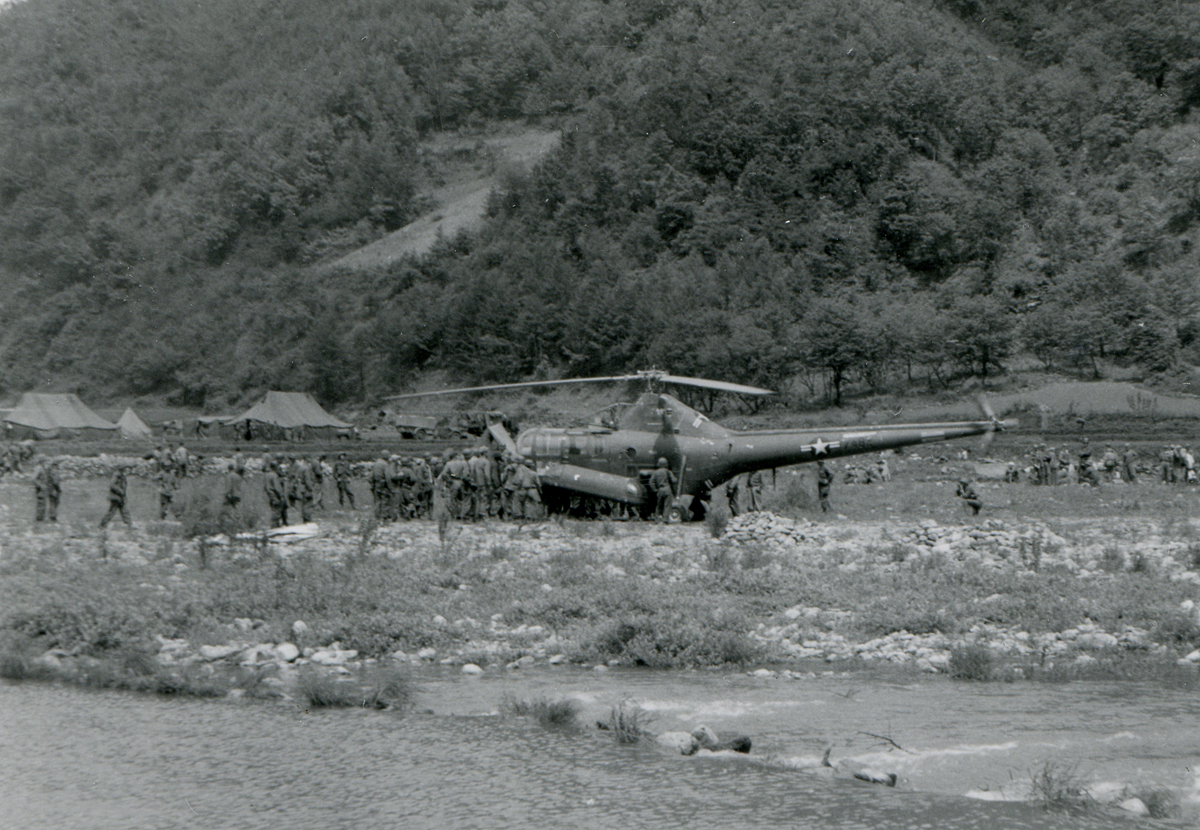
4 August 1950: During the Battle of the Pusan Perimeter, wounded soldiers were evacuated from the battlefield by helicopter for the first time when a Sikorsky H-5F of Detachment F, 3rd Emergency Rescue Squadron,¹ Air Rescue Service, United States Air Force, flew Private 1st Class Claude C. Crest, Jr., U.S. Army, from the Sengdang-ni area to an Army hospital. By the end of combat in 1953, 21,212 soldiers had been medevaced by helicopters.
Only the second military helicopter, the H-5 was frequently flown overloaded and outside of its center of gravity limits. The helicopter was not armed, though the pilot normally carried an M1911 .45-caliber semi-automatic pistol, and the crewman, a .30-caliber M1 Carbine.
 Eleven commercial Sikorsky S-51 helicopters had been purchased by the Air Force in 1947 and designated R-5F. This was later changed to H-5F. It was a four-place, single-engine helicopter, operated by one pilot. The cabin was built of aluminum with Plexiglas windows. The fuselage was built of plastic-impregnated plywood, and the tail boom was wood monocoque construction. The main rotor consisted of three fully-articulated blades built of metal spars and plywood ribs, covered with two layers of fabric. (All metal blades soon became available.) The three bladed semi-articulated tail rotor was built of laminated wood. The main rotor turned counter-clockwise, as seen from above. (The advancing blade is on the helicopter’s right.) Its normal operating range was 175–195 r.p.m. The tail rotor was mounted on the helicopter’s left side in a pusher configuration. It turned clockwise as seen from the helicopter’s left. (The advancing blade is below the axis of rotation.)
Eleven commercial Sikorsky S-51 helicopters had been purchased by the Air Force in 1947 and designated R-5F. This was later changed to H-5F. It was a four-place, single-engine helicopter, operated by one pilot. The cabin was built of aluminum with Plexiglas windows. The fuselage was built of plastic-impregnated plywood, and the tail boom was wood monocoque construction. The main rotor consisted of three fully-articulated blades built of metal spars and plywood ribs, covered with two layers of fabric. (All metal blades soon became available.) The three bladed semi-articulated tail rotor was built of laminated wood. The main rotor turned counter-clockwise, as seen from above. (The advancing blade is on the helicopter’s right.) Its normal operating range was 175–195 r.p.m. The tail rotor was mounted on the helicopter’s left side in a pusher configuration. It turned clockwise as seen from the helicopter’s left. (The advancing blade is below the axis of rotation.)

The helicopter’s fuselage was 41 feet, 1¾ inches (12.541 meters) long. The main rotor had a diameter of 48 feet, 0 inches (14.630 meters) and the tail rotor diameter was 8 feet, 5 inches (2.565 meters),² giving the helicopter an overall length of 57 feet, ½ inch (17.386 meters) with rotors turning. It was 12 feet, 11–3/8 inches (3.947 meters) high. The tricycle landing gear had a wheel base of 10 feet, 1 inch (3.073 and the tread was 12 feet, 0 inches (3.658 meters). The S-51 had an empty weight of 4,050 pounds (1,837 kilograms) and maximum gross weight of 5,300 pounds (2,404 kilograms) below 1,000 feet (305 meters) MSL.³ Fuel capacity was 100 gallons (379 liters).
 The H-5F was powered by an air-cooled, supercharged, 986.749-cubic-inch-displacement (16.170 liter) Pratt & Whitney R-985 AN-5 (Wasp Jr. T1B4 ) which was placed in the fuselage behind the crew compartment with the crankshaft vertical. The R-985-AN-5 was a direct-drive, nine-cylinder radial engine with a compression ratio of 6:1. It required 91-octane aviation gasoline and was rated at 450 horsepower at 2,300 r.p.m., Standard Day at Sea Level. The R-985 AN-5 was 48.00 inches (1.219 meters) long, 46.25 inches (1.175 meters) in diameter and weighed 684 pounds (310.3 kilograms) with a magnesium crankcase.
The H-5F was powered by an air-cooled, supercharged, 986.749-cubic-inch-displacement (16.170 liter) Pratt & Whitney R-985 AN-5 (Wasp Jr. T1B4 ) which was placed in the fuselage behind the crew compartment with the crankshaft vertical. The R-985-AN-5 was a direct-drive, nine-cylinder radial engine with a compression ratio of 6:1. It required 91-octane aviation gasoline and was rated at 450 horsepower at 2,300 r.p.m., Standard Day at Sea Level. The R-985 AN-5 was 48.00 inches (1.219 meters) long, 46.25 inches (1.175 meters) in diameter and weighed 684 pounds (310.3 kilograms) with a magnesium crankcase.
The H-5F had a maximum speed (VNE) of 107 knots (123 miles per hour/198 kilometers per hour). Range was 275 miles (443 kilometers). The service ceiling was 14,800 feet (4,511 meters). The absolute hover ceiling was 3,000 feet (914 meters).

¹ Reorganized as the 3rd Air Rescue Squadron 10 August 1950.
² An 8 foot, 9 inch (2.667 meter) all-metal two-blade tail rotor assembly became standard with the H-5G, and was available to retrofit earlier helicopters.
³ The maximum gross weight had to be reduced 150 pounds (68 kilograms) for each additional 1,000 feet of altitude.
© 2018, Bryan R. Swopes
On May 16th, 1950 Col. Santini of the French Air Force carried out a medevac with a Hiller 360 at Tan-Uyen in Southern Vietnam (Cochinchina in those days). Unless the British carried out any similar missions earlier in Malaya, this qualifies as the first military helicopter medevac in history. The rescue of stranded passengers from SABENA’s crashed DC4 OO-CBG in Gander in December 1946 is the very first chopper medevac.
The 1st Air Commando Group, the first helicopter combat mission, the first helicopter combat rescue.
April 1944 – Lt. Mark Harmon, US Army. WWII, Burma in Sikorsky YR-4B.
Kyron, please see This Day in Aviation for 21–25 April 1944: https://www.thisdayinaviation.com/21-april-1944/
Bryan, All the reference sources I have seen for the Wasp Jr. list it as having a 2-piece aluminum alloy crankcase and not magnesium. My source is Aircraft Engines of the World 1946 by Paul H. Wilkinson. I look foward to reading TDiA every day and enjoy very much.
Thanks, Carl, but I think I’m right on this one: My source is a data sheet from Pratt & Whitney Aircraft Engines, dated July 2, 1956. Notes on the specific model engine state that the R-985 AN-5 is for “Vertical installation. Magnesium crankcase.”